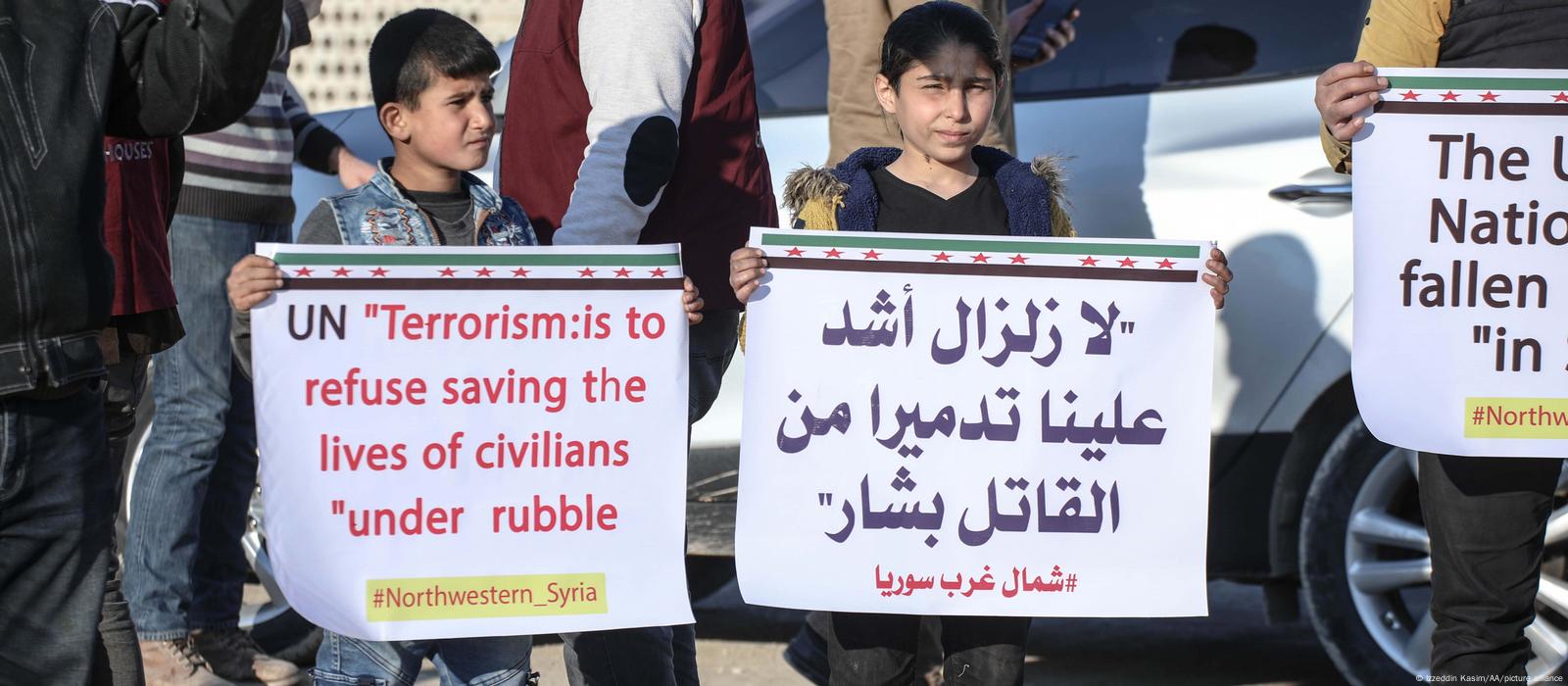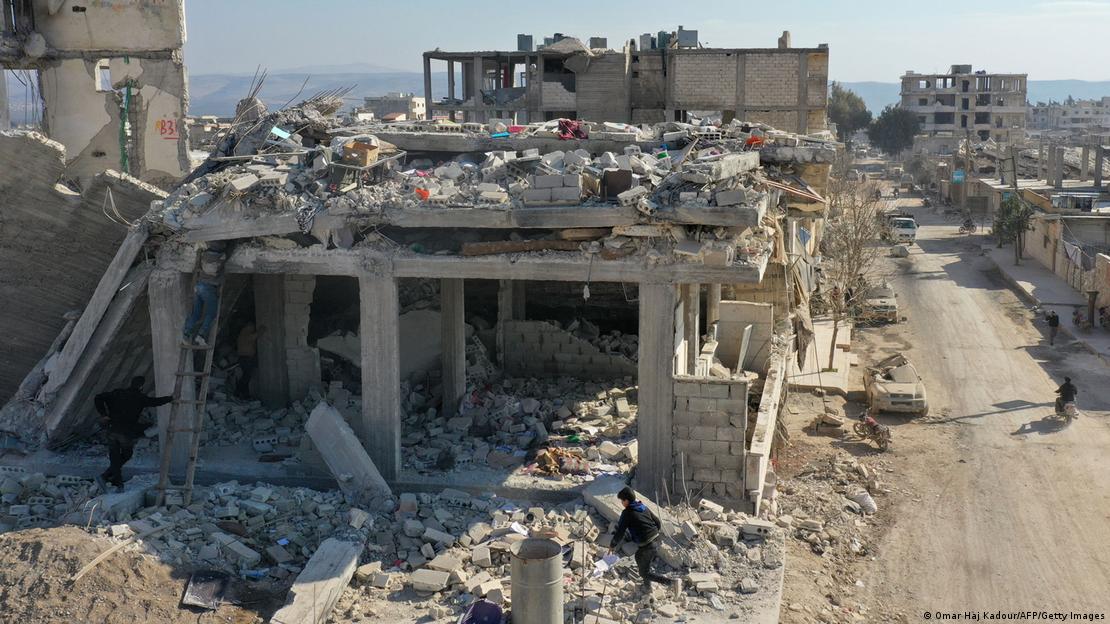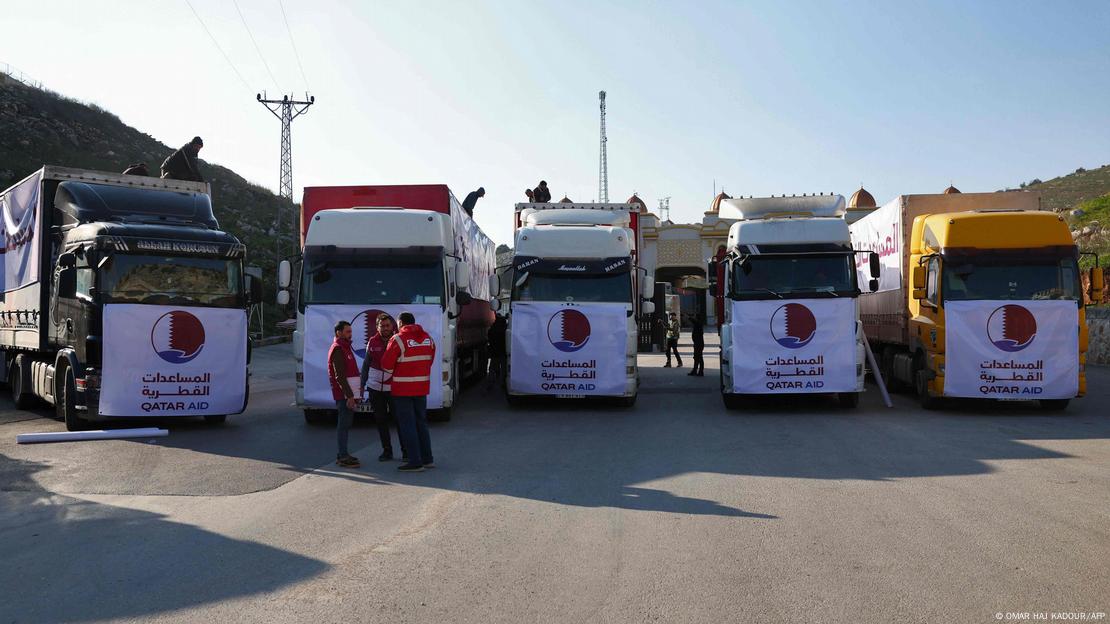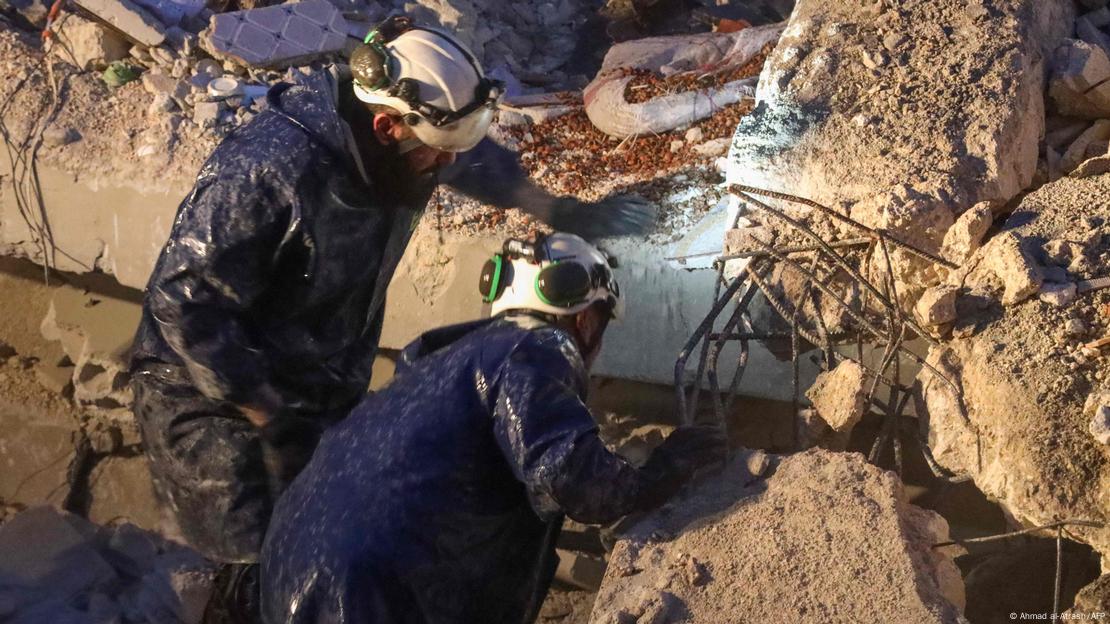
Earthquake aid to northern Syria: Why did it take so long?
Cathrin Schaer
02/18/2023
February 18, 2023
It has taken longer for humanitarian aid to reach earthquake victims in northern Syria than almost anywhere else. Those people who dug through rubble with bare hands and lost loved ones want to know why.
When the earthquake hit, Ramadan Hilal and his family left their home in Jinderes, northern Syria, in a panic. "Everyone was barefoot," he told DW. "We ran for our lives, injured and carrying nothing."
Now, almost two weeks after the earthquake, Hilal's situation has still not improved. Jinderes is one of the worst affected towns in this area and Hilal, who left his hometown of Aleppo seven years ago because of the Syrian civil war, is now living with his family in a self-made tent near what remains of their home.
He's been trying to scavenge useful items from inside the ruined house, even though the building is in danger of collapse.
"Even this tent [we're living in], I had to borrow the iron frame and purchase the sheet [covering it] myself," Hilal complains. "We haven't received any aid until now."
Slow start to aid deliveries to Syria
Four days after the earthquake, the first aid convoys arrived in the area. But these had been on their way before the disaster. So it is only this week that aid convoys — carrying tents, medication, food and other supplies — began arriving in the area in any significant number.
Locals like Hilal, who are struggling to survive in the winter temperatures, say it's too little and much too late. Over the past days, there have been many stories about rescuers desperately clearing rubble with their bare hands, only to hear buried survivors' voices eventually fall silent.
Why has it taken so long?
There are just over 4 million people living in this this area, mostly Syrians displaced from other parts of the country during the country's long civil war. The area is controlled by various groups that oppose the Syrian government.
Years of fighting, ad-hoc governance and direct attacks on infrastructure by Syria and its ally, Russia, mean that medical facilities and other emergency services were already under pressure or non-existent. The majority of the civilians living in this part of Syria were dependent on international humanitarian aid to survive even before this latest disaster.
And getting aid and supplies into this opposition-controlled area has long been political.
It has taken longer for humanitarian aid to reach earthquake victims in northern Syria than almost anywhere else. Those people who dug through rubble with bare hands and lost loved ones want to know why.
When the earthquake hit, Ramadan Hilal and his family left their home in Jinderes, northern Syria, in a panic. "Everyone was barefoot," he told DW. "We ran for our lives, injured and carrying nothing."
Now, almost two weeks after the earthquake, Hilal's situation has still not improved. Jinderes is one of the worst affected towns in this area and Hilal, who left his hometown of Aleppo seven years ago because of the Syrian civil war, is now living with his family in a self-made tent near what remains of their home.
He's been trying to scavenge useful items from inside the ruined house, even though the building is in danger of collapse.
"Even this tent [we're living in], I had to borrow the iron frame and purchase the sheet [covering it] myself," Hilal complains. "We haven't received any aid until now."
Slow start to aid deliveries to Syria
Four days after the earthquake, the first aid convoys arrived in the area. But these had been on their way before the disaster. So it is only this week that aid convoys — carrying tents, medication, food and other supplies — began arriving in the area in any significant number.
Locals like Hilal, who are struggling to survive in the winter temperatures, say it's too little and much too late. Over the past days, there have been many stories about rescuers desperately clearing rubble with their bare hands, only to hear buried survivors' voices eventually fall silent.
Why has it taken so long?
There are just over 4 million people living in this this area, mostly Syrians displaced from other parts of the country during the country's long civil war. The area is controlled by various groups that oppose the Syrian government.
Years of fighting, ad-hoc governance and direct attacks on infrastructure by Syria and its ally, Russia, mean that medical facilities and other emergency services were already under pressure or non-existent. The majority of the civilians living in this part of Syria were dependent on international humanitarian aid to survive even before this latest disaster.
And getting aid and supplies into this opposition-controlled area has long been political.

The town of Jinderes is among the worst affected by the earthquake in northern Syria
Omar Haj Kadour/AFP/Getty Images
The Syrian government, headed by dictator Bashar Assad, insists all humanitarian aid should be channeled through Damascus. In practice, Assad used international aid deliveries both to enrich himself and his supporters by taking a cut, and to ensure that his enemies in opposition-held areas were starved of supplies.
This is why, early in the civil war, the UN and humanitarian organizations insisted aid be delivered across the Turkish border, directly into opposition-held areas, and without asking permission from the Assad regime. This is how the majority of aid has arrived in opposition-held areas over past years.
In mid-2014, the United Nation's Security Council, or UNSC, got involved in making decisions on aid for Syria.
Security Council members decided that UN humanitarian agencies and their partners should be allowed to use four different border crossings — two through Turkey and one each through Jordan and Iraq — without asking for permission.
However since 2014, the situation has changed radically because of Russia's increased military support for Assad from around 2015, and then after 2022, the Russian invasion of Ukraine, which has heightened diplomatic tensions inside the UNSC itself.
The Syrian government, headed by dictator Bashar Assad, insists all humanitarian aid should be channeled through Damascus. In practice, Assad used international aid deliveries both to enrich himself and his supporters by taking a cut, and to ensure that his enemies in opposition-held areas were starved of supplies.
This is why, early in the civil war, the UN and humanitarian organizations insisted aid be delivered across the Turkish border, directly into opposition-held areas, and without asking permission from the Assad regime. This is how the majority of aid has arrived in opposition-held areas over past years.
In mid-2014, the United Nation's Security Council, or UNSC, got involved in making decisions on aid for Syria.
Security Council members decided that UN humanitarian agencies and their partners should be allowed to use four different border crossings — two through Turkey and one each through Jordan and Iraq — without asking for permission.
However since 2014, the situation has changed radically because of Russia's increased military support for Assad from around 2015, and then after 2022, the Russian invasion of Ukraine, which has heightened diplomatic tensions inside the UNSC itself.

More convoys of trucks carrrying much-needed supplies began arriving in northern Syria this week
OMAR HAJ KADOUR/AFP
The idea of cross-border aid into northwestern Syria has become a political bargaining chip, with Russia using its permanent seat on the UNSC to support the Assad regime and exact concessions from other UNSC members. From 2020 on, at Russian insistence, the UNSC has allowed only one Turkish-Syrian border crossing to be used for aid deliveries.
So who was really to blame?
That was the situation when two devastating earthquakes struck early on February 7.
By February 13, the Assad regime agreed that two further Turkish border crossings could be opened for three months. While Assad's supporters argue that international sanctions are to blame, Assad's critics say that the Syrian government had deliberately waited so long for cynical, political reasons.
Opening the borders is "a way for the regime to … instrumentalize this tragedy for its own political purposes," Joseph Daher, an expert on Syria at the European University Institute in Italy, told the Washington Post.

The White Helmets were the first, and for a long time, the only, rescuers in opposition held parts of northern Syria
Image: Ahmad al-Atrash/AFP
"We have seen, time and again, that the Syrian government is more than capable and willing to manipulate emergency crises to expand its control," added Jesse Marks, senior advocate for the Middle East at Refugees International, in a statement.
Blaming the United Nations
Meanwhile others said it was the UN that was to blame. The Turkish government had apparently agreed to open two more crossings as early as February 8 but the UN decided to wait for the Syrian government to agree too.
"When I asked the UN why help had failed to arrive in time, the answer I received was bureaucracy," Raed Saleh, head of the Syrian volunteer rescue group, the White Helmets, wrote in an op-ed for CNN this week. "In the face of one of the deadliest catastrophes to strike the world in years, it seems the UN's hands were tied by red tape.
"It's a Catch 22 for the UN," Ibrahim Olabi, a lawyer and founder of the Syrian Legal Development Program, previously told DW. If the UN ignores the difficult politics behind the border-crossing debate, and the UNSC mandate, "then they're at risk of endangering their relationship with Damascus and they can't work there anymore."
"There was no reason the UN should have waited a week to secure this superfluous permission [to open borders] and present it as a triumph of diplomacy," editor Muhammad Idrees Ahmad pointed out in an essay published this week in the foreign policy magazine New Lines. "It was akin to requesting Russian permission to deliver aid to Ukraine," Ahmad argued.
Other organizations had similar arguments to make. "The slow humanitarian response to the earthquakes [in northern Syria] … highlights the inadequacy of the UNSC-mandated cross border aid mechanism in Syria and the urgent need for alternatives," Human Rights Watch said in a statement this week.
"We have seen, time and again, that the Syrian government is more than capable and willing to manipulate emergency crises to expand its control," added Jesse Marks, senior advocate for the Middle East at Refugees International, in a statement.
Blaming the United Nations
Meanwhile others said it was the UN that was to blame. The Turkish government had apparently agreed to open two more crossings as early as February 8 but the UN decided to wait for the Syrian government to agree too.
"When I asked the UN why help had failed to arrive in time, the answer I received was bureaucracy," Raed Saleh, head of the Syrian volunteer rescue group, the White Helmets, wrote in an op-ed for CNN this week. "In the face of one of the deadliest catastrophes to strike the world in years, it seems the UN's hands were tied by red tape.
"It's a Catch 22 for the UN," Ibrahim Olabi, a lawyer and founder of the Syrian Legal Development Program, previously told DW. If the UN ignores the difficult politics behind the border-crossing debate, and the UNSC mandate, "then they're at risk of endangering their relationship with Damascus and they can't work there anymore."
"There was no reason the UN should have waited a week to secure this superfluous permission [to open borders] and present it as a triumph of diplomacy," editor Muhammad Idrees Ahmad pointed out in an essay published this week in the foreign policy magazine New Lines. "It was akin to requesting Russian permission to deliver aid to Ukraine," Ahmad argued.
Other organizations had similar arguments to make. "The slow humanitarian response to the earthquakes [in northern Syria] … highlights the inadequacy of the UNSC-mandated cross border aid mechanism in Syria and the urgent need for alternatives," Human Rights Watch said in a statement this week.

Parts of Syria under government control, like Aleppo, were also impacted by the earthquake but received help more quickly
Image: FIRAS MAKDESI/REUTERS
Profitting from disaster
But it wasn't just UN hesitation causing problems with aid shipments. Some aid convoys trying to cross from government-run parts of Syria into opposition-controlled areas were blocked by opposition fighters themselves.
Human Rights Watch reported that groups like Hayat Tahrir al-Sham turned trucks away because they refuse to accept anything from a government that has bombed, starved and shot at them for years. So did fighters from Turkish-backed militias in other parts of northern Syria.
Additionally, reports came in that the various independent militias operating in the area were taking a cut from aid shipments passing through their checkpoints, so they could distribute this to people in their own areas. This was common practice before the earthquake too.
The Syrian government is allegedly also involved in this kind of skimming. An aid worker in the area told Human Rights Watch that a Syrian aid convoy heading into opposition-held areas had been blocked from travelling further by local officials unless it handed over half of its cargo. Later videos on social media showed packages marked with UN and Syrian Red Crescent logos being sold in Damascus and other Syrian cities.
No comments:
Post a Comment